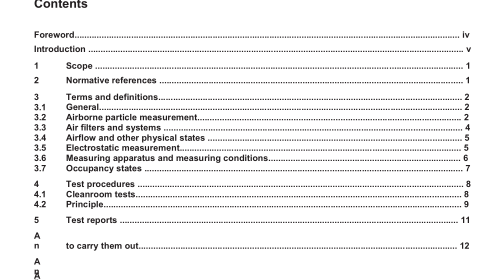EN ISO 14644-3:2005 – Cleanrooms and associated controlled environments – Part 3: Test methods

1 Scope This part of ISO 14644 specifies test methods for designated classification of airborne particulate cleanliness and for characterizing the performance of cleanrooms and clean zones. Performance tests are specified for two types of cleanrooms and clean zones: those with unidirectional flow and those with non-unidirectional flow, in three possible occupancy states: as-built, at-rest and operational. The test methods recommend test apparatus and test procedures for determining performance parameters. Where the test method is affected by the type of cleanroom or clean zone, alternative procedures are suggested. For some of the tests, several different methods and apparatus are recommended to accommodate different end-use considerations. Alternative methods not included in this part of ISO 14644 may be used if based on agreement between customer and supplier. Alternative methods do not necessarily provide equivalent measurements. This part of ISO 14644 is not applicable to the measurement of products or of processes in cleanrooms or separative devices.
2 Normative references
The following referenced documents are indispensable for the application of this document. For dated references, only the edition cited applies. For undated references, the latest edition of the referenced document (including any amendments) applies.
3 Terms and definitions
For the purposes of this document, the following terms and definitions apply.
3.1 General
3.1.1
cleanroom
room in which the concentration of airborne particles is controlled, and which is constructed and used in a manner to minimize the introduction, generation and retention of particles inside the room, and in which other relevant parameters, e.g. temperature, humidity and pressure, are controlled as necessary
[ISO 14644-1:1999, 2.1.1]
3.1.2
clean zone
dedicated space in which the concentration of airborne particles is controlled, and which is constructed and sed in a manner to minimize the introduction, generation and retention of particles inside the zone, and in which other relevant parameters, e.g. temperature, humidity and pressure, are controlled as necessary NOTE This zone may be open or enclosed, and may or may not be located within a cleanroom.
[ISO 14644-1:1999, 2.1.2]
3.1.3
installation
cleanroom or one or more clean zones, together with all associated structures, air-treatment systems,services, and utilities
[ISO 14644-1:1999, 2.1.3]
3.1.4
separative device
equipment utilizing constructional and dynamic means to create assured levels of separation between the inside and outside of a defined volume
NOTE Some industry-specific examples of separative devices are clean air hoods, containment enclosures, glove boxes, isolators and mini-environments.
3.2 Airborne particle measurement
3.2.1
aerosol generator
instrument capable of generating particulate matter having appropriate size range (e.g. 0,05 µm to 2 µm) at a constant concentration, which may be produced by thermal, hydraulic, pneumatic, acoustic or electrostatic means
EN ISO 14644-3:2005 – Cleanrooms and associated controlled environments – Part 3: Test methods